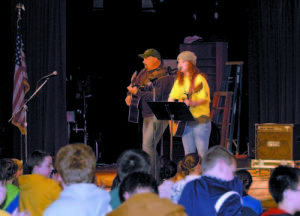Country singer helps drive home anti-bullying message

A CHALLENGE — Country singer Lexi James challenged Lake Region Middle School students to make their school free of bullying. (Rivet Photo)
By Wayne E. Rivet
Staff Writer
Lexi James knows how it feels to be bullied.
She was the target of mean-spirited kids because she has “flaming red, curly hair.â€
She was made fun of because she stuttered when she was nervous.
When Lexi was asked what she hoped to be when she was older, she was ridiculed because her dream was to be a successful country singer and songwriter.
“Middle school and high school can be such a hard time for so many kids. There is so much pressure to fit in. I spent too much time pretending to be something I am not just so people would like me. Eventually, I couldn’t take it anymore. I started to act like the real me. That didn’t go so well,†wrote Lexi on the Pacer Center’s Teens Against Bullying website. “When my senior year was over, I was also the only one in my graduating class who didn’t go to college. I decided to pursue a career in music instead and everyone had an opinion about that. People made me feel stupid and even the teachers took digs at me in front of my classmates. That summer, my ‘friends’ turned on me. They decided I was a fake and a hypocrite. They posted so many negative, hurtful things about me on the Internet even though I blocked them from my Facebook page. I wouldn’t wish this kind of cyberbullying on anyone.â€
Lexi admits she likes being “different†and a bit “over the top.†She is a dreamer and is brave enough to pursue her passions.
Music is her escape.
Using music and her own story, Lexi recently spoke with Lake Region Middle School students about bullying.
SAD 61 launched an anti-bullying campaign in September, using the theme, “See, Say, Do Something.â€
What is bullying? A behavior that hurts or harms another person physically or emotionally; and the target has difficulty stopping the behavior directed at him/her and struggles to defend himself/herself.
Some national statistics on bullying:
• One out of four teens is bullied.
• 35% of kids have been threatened online. Nearly one in five have had it happen more than once.
• 21% of kids have received mean or threatening e-mail or other messages.
• 58% of kids admit someone has said mean or hurtful things to them online.

HER TIME TO SHINE — Singer and songwriter Lexi James performed "This is my time" during an anti-bullying program for Lake Region Middle School students. (Rivet Photo)
Lexi James was invited to LRMS to drive home the message that bullying is wrong, and everyone within a community must stand up to fight this growing, dangerous epidemic. Her hour-long presentation included a talk defining what bullying is and skits, which illustrated the difference between a “respectful†disagreement — which no one is “mean†or picked on — vs. bullying, as well as one which showed how bystanders can safely come to the aid of someone who is being bullied.
The high-energy performer gave a benefit concert that evening, raising money for anti-bullying efforts.
A spokeswoman for PACER Center’s Teens Against Bullying project, Lexi also performed her original song, This is My Time.
Lexi co-wrote the song with her keyboard player in just two days to “show other people they aren’t alone, that they are not the only ones who feel this way.†Lexi added, “Just because people say horrible things about you doesn’t make it true.â€
You told me I was stupid,
You told me I would always be worthless,
And I believed you.
You told me I would never amount to anything,
Don’t underestimate me,
I’m going to be somebody,
Look out,
It’s my time to shine.
Say what you want about me,
There is no way you’ll break me down,
Look at me now,
This is my time.
“This song is for the underdog — people who haven’t yet gained the strength to ignore the bullies; people who still feel like they will never amount to anything; people who have been told over and over again that they are stupid and worthless,†she said. “I hope that you listen with your heart to the person you know you are inside. Despite what anybody has to say, you’re gonna be somebody! This is your time!â€
Lexi told LRMS students that 160,000 kids are bullied every day. “I was one of them,†she said. “I had anxiety and depression because I was picked on.â€
Some end in tragedy, while others could easily push victims over the edge:
October 25, 2012: Felicia Garcia, age 15, jumped to her death in front of a train in New York after two football players bragged about sexual conquests with the high school freshman.
“Later on, they wouldn’t leave her alone about it. They just kept bullying her and bullying her,†a close friend told a New York newspaper.
Felicia tweeted on Monday, “I can’t. I’m done. I give up.†She died Thursday.
November 2012: A former Orono High School student is charged with felony terrorizing and harassment by electronic communication charges after posting dozens of threatening, anonymous messages on an Internet account of a former classmate she thought was flirting with her boyfriend.
Veazie Police Sgt. Keith Emery said, “I’ve handled harassment calls for 24 years and have never seen threats as violent, disgusting and vulgar as these.â€
Comments posted in the newspaper account included: “Your face is like a baby seal. Fat, furry and just asking to be clubbed to death†and “Ready for tomorrow night? I’d learn to sleep with your eyes open if I were you. I’m dulling my knife right now so when I stab you in the face, gut and legs, it’ll be painful as possible.â€
Research has shown that 30% of U.S. students in grades six through 10 are involved in moderate or frequent bullying — as bullies, as victims or as both.
Lexi James challenged local students to make LRMS as bully-free school.
“No one deserves to be bullied or picked on…no one,†she said.
Bullying fact sheet
“Although bullying was once considered a rite of passage, parents, educators and community leaders now see bullying as a devastating form of abuse that can have long-term effects on youthful victims, robbing them of self-esteem, isolating them from their peers, causing them to drop out of school and even prompting health problems and suicide,†— National Crime Prevention Council.
According to the U.S. National Institute of Health:
• Every 30 minutes, a teenager attempts suicide due to bullying.
• About 47 teens are bullied every five minutes.
• Victims of cyberbullying show more signs of depression than other bullying victims.
• Cyberbullying is on the rise in dramatic numbers; it is relentless and more frightening if the bully is anonymous.
• 71% of students report bullying as an ongoing problem.
• Teens in grades 6 through 10 are most likely to be involved in activities related to bullying.
The American Academy of Pediatrics calls cyberbullying the “most common online risk for all teens.â€
Cyberbullying is deliberately using digital media to communicate false, embarrassing or hostile information about or to another person.
Some cyberbullying facts:
• 32% of online teens say they have been targets of a range of annoying or potential menacing online activities.
• 15% of teens overall say someone has forwarded or posted a private message they’ve written, 13% say someone has spread a rumor about them online, 13% say someone has sent them a threatening or aggressive message, and 6% say someone has posted embarrassing pictures of them online.
• 38% of online girls report being bullied, compared with 26% of online boys. In particular, 41% of older girls (15-17) report being bullied — more than any other age or gender group.
• 39% of social network users have been cyberbullied in some way, compared with 22% of online teens who do not use social networks.
• 20% of teens (12-17) say “people are mostly unkind†on online social networks. Younger teenage girls (12-13) are considerably more likely to say this. One in three (33%) younger teen girls who use social media say that people their age are “mostly unkind†to one another on social network sites.
• 15% of teens on social networks have experienced someone being mean or cruel to them on a social network site. There are no statistically significant differences by age, gender, race, socioeconomic status, or any other demographic characteristic.
• 88% of social media-using teens say they have seen someone be mean or cruel to another person on a social network site. 12% of these say they witness this kind of behavior “frequently.â€
• When teens see others being mean or cruel on social networks, frequently 55% see other people just ignoring what is going on, 27% see others defending the victim, 20% see others telling the offender to stop, and 19% see others join in on the harassment.
• 36% of teens who have witnessed others being cruel on social networks have looked to someone for advice about what to do.
• 67% of all teens say bullying and harassment happens more offline than online.
• 1 in 6 parents know their child has been bullied over social media. In over half of these cases, their child was a repeat victim. Over half of parents whose children have social media accounts are concerned about cyberbullying and more than three-quarters of parents have discussed the issue of online bullying with their children.
• 11% of middle school students were victims of cyberbullying in the past two months. Girls are more likely than boys to be victims or bully/victims.

